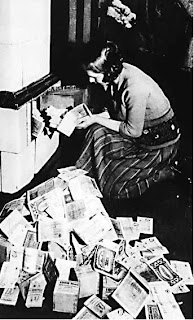| The 100 trillion Zimbabwean dollar banknote (1014 dollars), the largest banknote ever in terms of the number of zero's on it |
| Sweeping up the banknotes from the street after the Hungarian pengő was replaced in 1946 after the biggest inflation the world had ever faced |
| Germany, 1923: banknotes had lost so much value that they were used as wallpaper. |
Hyperinflation is generally associated with paper money because this can easily be used to increase the money supply: add more zeros to the plates and print, or even stamp old notes with new numbers.Historically there have been numerous episodes of hyperinflation in various countries, followed by a return to "hard money". Older economies would revert to hard currency and barter when the circulating medium became excessively devalued, generally following a "run" on the store of value.Hyperinflation effectively wipes out the purchasing power of private and public savings, distorts the economy in favor of extreme consumption and hoarding of real assets, causes the monetary base, whether specie or hard currency, to flee the country, and makes the afflicted area anathema to investment.
The worst inflation occurred in Hungary between the end of 1945 and July 1946. In 1944, the highest denomination was 1,000 pengő. A special currency the adópengő - or tax pengő - was created for tax and postal payments & later by Forint. The value of the adópengő was adjusted each day, by radio announcement. On 1 January 1946 one adópengő equaled one pengő. On 18 August 1946, one forint equaled 400 octillion or 400,000,000,000,000,000,000,000,000,000 pengő.
| The 100 million b.-pengő note was the highest denominated banknote ever issued, equaling 100 quintillion (1020) Hungarian pengő |
 |
| A German lady burning worthless notes |
 |
| German kids playing with banknotes |
References & more reading
1.Wikipedia, the free encyclopedia
2.http://moneytipcentral.com/inflation-in-america-what-will-hyperinflation-look-like
good one!! even though i hv seen the pictures and article in wikipedia before, its nice to see someone else noticing it. Remember last yr we had a situation in india wer inflation was negative, someting like -1.6%, it was the time i ws interrested in this matter and i looked for articles suggesting that...and thats wen i came across the one in wikipedia regarding hyperinflation...good one though!!
ReplyDelete